
Score breakdown
Things we like
- RMA’s conversion work is mighty impressive
- V6TT is strong and responsive. Who needs a V8?
- Ride and handling is nicely judged and superior to US versions
- Clever towing aids work well
Not so much
- A newer MY24 model is already on sale in the US
- Lariat is a whopping $33K more than XLT
- Some buyers still might lust for a V8
- Payload is lower than key rivals
You already know the Ford F-150 is popular – it is one of the world’s best-selling vehicles, after all – but it’s the sheer scale of that popularity that might surprise you.
In the US, a new F-150 rolls off the line in Dearborn every 52 seconds and, remarkably, Ford is selling them even faster than they can build them.
A new F-150 sale is racked up every 49 seconds, so it’s little wonder the ‘Effie’ has been America’s top-selling truck for almost five decades.
And now the F-150 has arrived Down Under
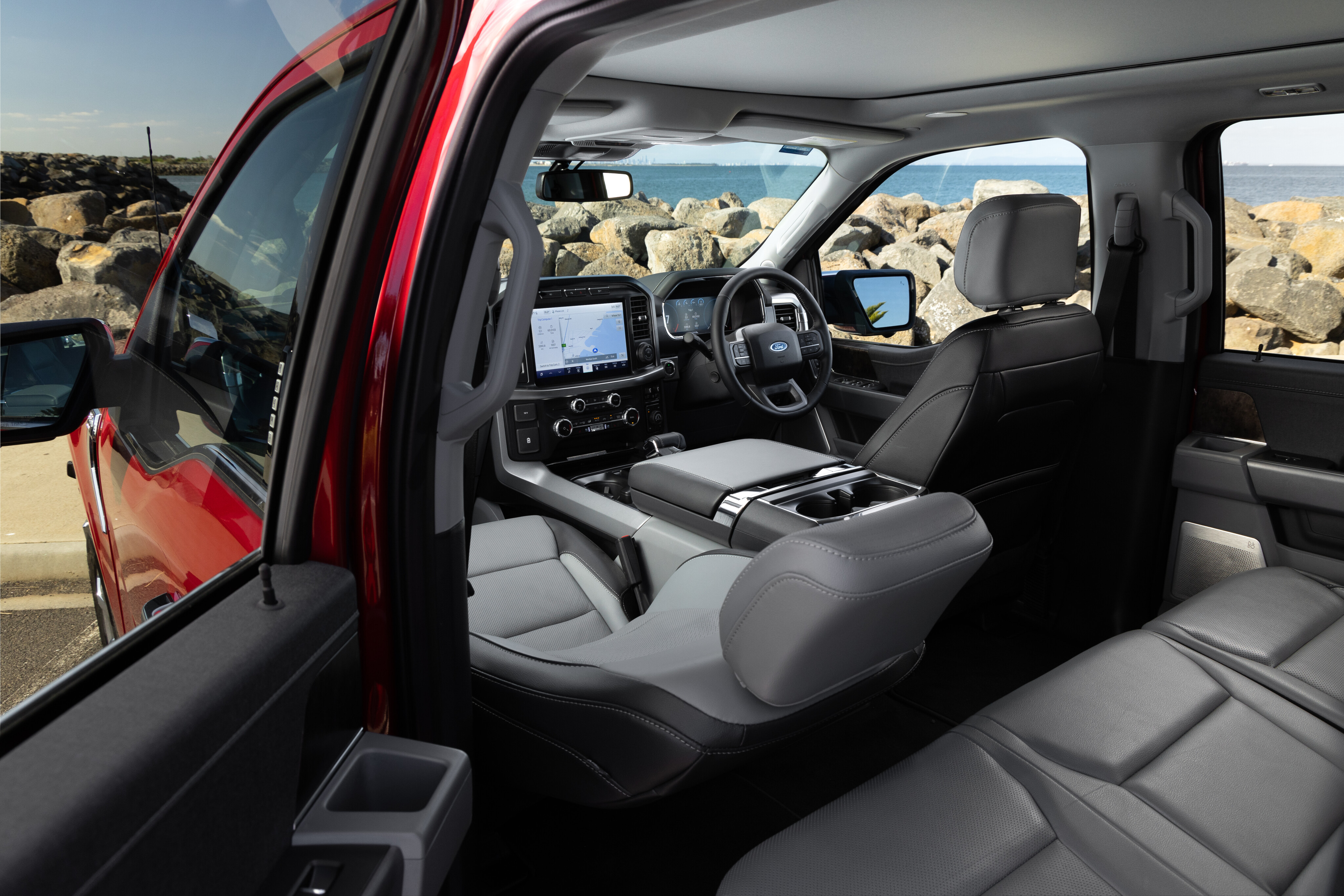
Or should we say returned?
Ford last sold the F Series here in 2006, when the F250 and ginormous F350 were imported in right-hand drive from Brazil, but this time around the project is far more ambitious.
Ford’s fresh conversion partner is RMA Automotive and the scale and meticulousness of the new joint venture has to be seen to be believed.
The work takes place at a brand new, 21,000sqm facility north of Melbourne, and if its footprint weren't enough of a hint, this is no small-time operation. Ford says it will remanufacture 20 units a day.
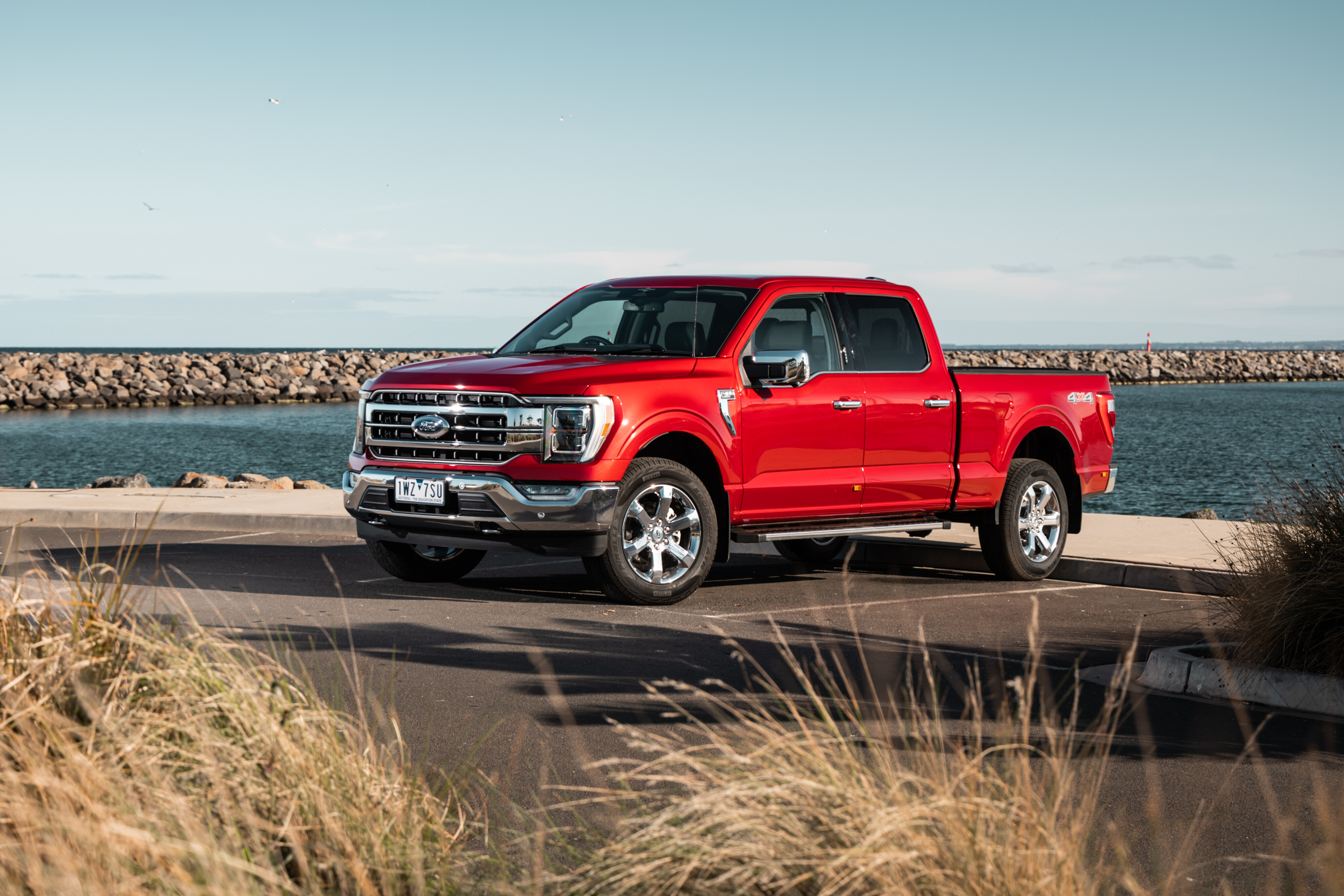
Remanufacture? You bet. Simply calling it a conversion undersells the depth and quality of the engineering involved.
At 20 trucks each day, that equates to around 5000 units a year and, in an indicator of just how popular full-size American utes are becoming in Australia, Ford and RMA say they can easily ramp up production to meet rising demand.
So how does Australia’s version of the F-150 stack up against the US original? And is it a smarter buy than the other big utes already on sale here, the RAM 1500 and Chevrolet Silverado? We climbed aboard the biggest and most expensive version of the F-150, the Lariat LWB, to find out.

How much is it and what do you get?
Ford offers two versions of the F-150 in Australia. The range opens at $106,950 for the XLT and stretches to $139,950 for the flagship Lariat we’re testing here.
Those prices are for the ‘short wheelbase’ versions, but for an extra $995 both the XLT and Lariat can be had in long-wheelbase form, which grafts an additional 300mm between the axles.
Buyers looking to lug about big loads will likely gravitate towards the LWB versions as every millimetre of that extra length is added to the tray, which grows to 2005mm long.

Mechanically, there’s little to separate the XLT and Lariat. Every version of the F-150 uses Ford’s 3.5-litre twin-turbo Ecoboost V6 that produces 298kW/768Nm – that’s right, unlike the RAM 1500 and Chevy Silverado there’s no V8 under the bonnet – and is paired with a smooth-shifting 10-speed automatic.
Both trim levels roll on 20-inch alloys, share the same basic chassis and suspension hardware, feature chrome bumpers, side steps and underbody skid plates, and crucially, they carry the same 4500kg braked towing capacity.

To help justify the Lariat’s hefty $33,000 premium over the XLT, Ford has loaded it with extra equipment.
You gain LED headlights, a leather steering wheel with electric adjustment, a two-piece panoramic sunroof, heated/cooled leather seats, a sliding window in the rear windscreen, and the gear shifter is mounted on the centre console rather than the steering column.
The Lariat also features a larger 12.0-inch centre touchscreen and a digital instrument cluster, with the centre screen in particular feeling like a huge upgrade compared to the XLT’s comparatively small 8.0-inch screen.

Enhanced engine noise is piped into the cabin in both the XLT and Lariat, but the higher quality audio system delivers a sound that’s richer, deeper and almost V8-like.
Perhaps the only debatable upgrade are the seats. In the Lariat they’re leather accented but we actually preferred the softer, more lounge-like cloth seats in the XLT.
One important distinction is that the Lariat scores a full-time 4x4 system, meaning you can switch to 4-Auto to help improve traction and stability while towing or on slippery surfaces.

There are some worthwhile upgrades to the Lariat’s tray, too, like a pair of LED lights, a 12V socket and an automatic tailgate. Both versions of the F-150 have a drop-in bed liner, moveable tie-down points and an integrated tailgate step that makes clambering into the tray much easier.
Finally, Lariat models score some desirable active safety gear missing from the XLT.
While both models include six airbags, autonomous emergency braking, blind-spot detection (with trailer coverage) and lane-keep assist, the Lariat builds on that with a host of additional advanced safety systems including: intelligent adaptive cruise control with stop and go, a 360 surround-view monitor, lane-centering, speed-sign recognition, intersection assist, and evasive steering assist.

Does all this justify the Lariat’s $33K premium over the XLT?
We reckon it does, mostly due to the bigger touchscreen, digital instrument cluster and full-time 4X4 system.
Ford also predicts the Lariat will be the more popular model grade and make up 65 percent of sales.
Ford F-150 vs rivals: key stats
| Ford F-150 Lariat LWB | RAM 1500 Big Horn | Chevrolet Silverado 1500 LTZ Premium | |
|---|---|---|---|
| Engine | 3.5L V6TT | 5.7L V8 | 6.2L V8 |
| Power/torque | 298kW/678Nm | 291kW/556Nm | 313kW/624Nm |
| Transmission | 10-speed auto | 8-speed auto | 10-speed automatic |
| Economy | 12.5L/100km | 12.2L/100km | 12.2L/100km |
| Braked towing | 4500kg | 4500kg | 4500kg |
| Payload | 710kg | 878kg | 757kg |
| L/W/H | 6184/2030/1995mm | 6142/2474/1968 | 5931/2086/1930mm |
| Wheelbase | 3994mm | 3898mm | 3750mm |
| Price | $140,945 | $127,950 | $121,000 |
| Warranty | 5yrs/unlimited | 3yrs/100,000km | 3yrs/100,000km |
Interior space, comfort and storage
Space, and loads of it, is clearly a huge attraction when buying an F-150 and it does not disappoint.
Clamber aboard any version of the Aussie F-150 range and you’re greeted by a cabin that feels massive and is also surprisingly comfortable and practical.
Storage cubbies abound. The door pockets are huge, there’s a dedicated slot for your phone (plus a wireless charging pad and twin USB outlets), and the wide centre console is colossal. The console can also double as a work space thanks to a lid the can be folded forwards to create a table big enough for a laptop.
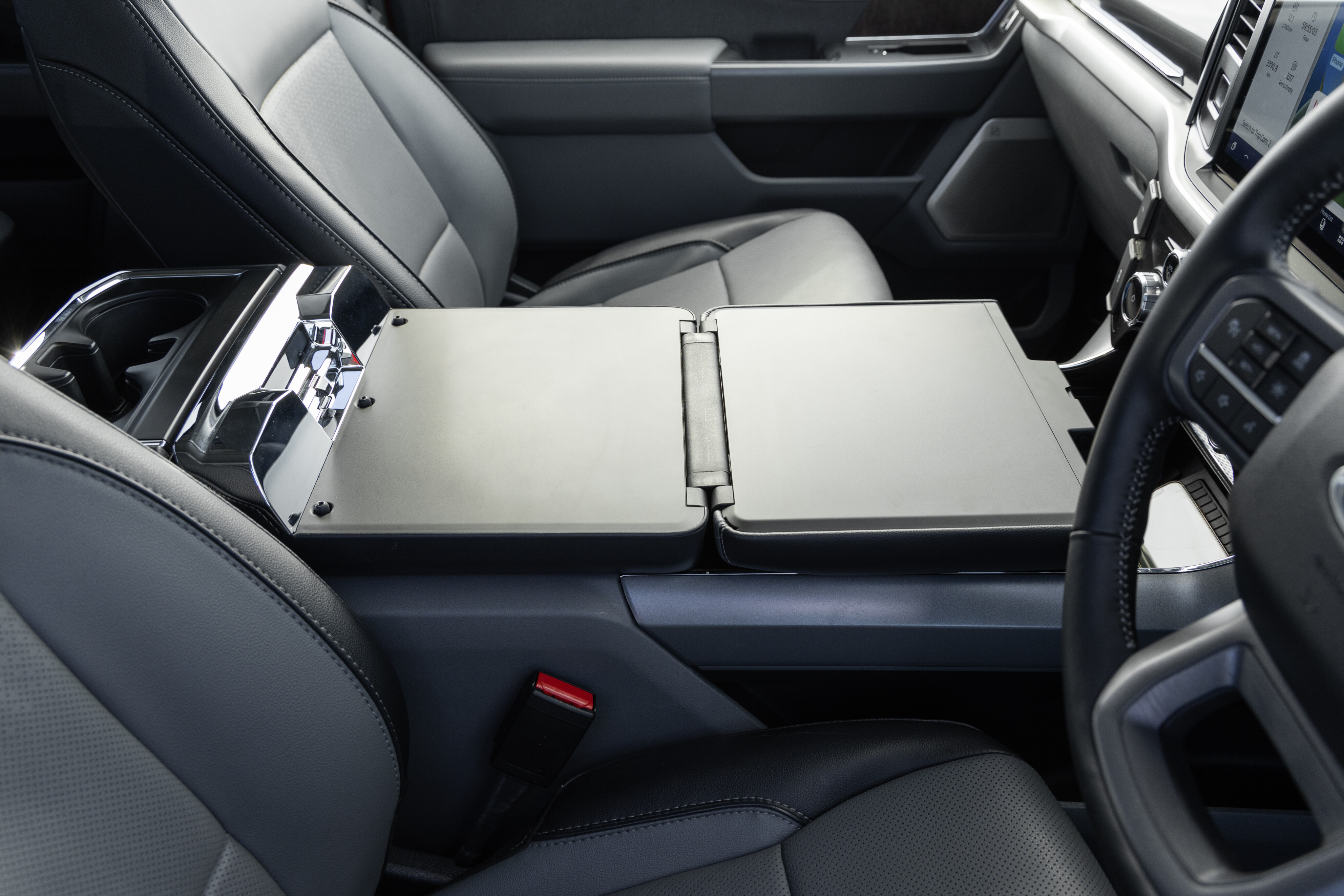
It’s a clever solution but one that requires an extra step in Lariat models. Because the Lariat’s shifter is on the console, rather than the steering column like the XLT, you need to press a button to electrically fold down the gear shifter. It’s a solution RMA is especially proud of, as re-engineering the collapsable shifter for right-hand-drive was a real challenge.
Remarkably the back seats feel even roomier than those in the front. Legroom is especially generous (it’s so roomy we reckon NBA basketballers will have space to spare) and like the front, the seat itself is comfortable and supportive.

Lariat versions also score heated rear seats and more USB ports, a power outlets and dedicate rear air vents are provided on the rear of the centre console.
The seat base also folds up and because the floor is also flat, with no intrusive transmission tunnel, it’s possible to use the entire section between the back doors for additional storage.
Lariat versions also score an extra storage box beneath the rear seat that’s missing in the XLT.
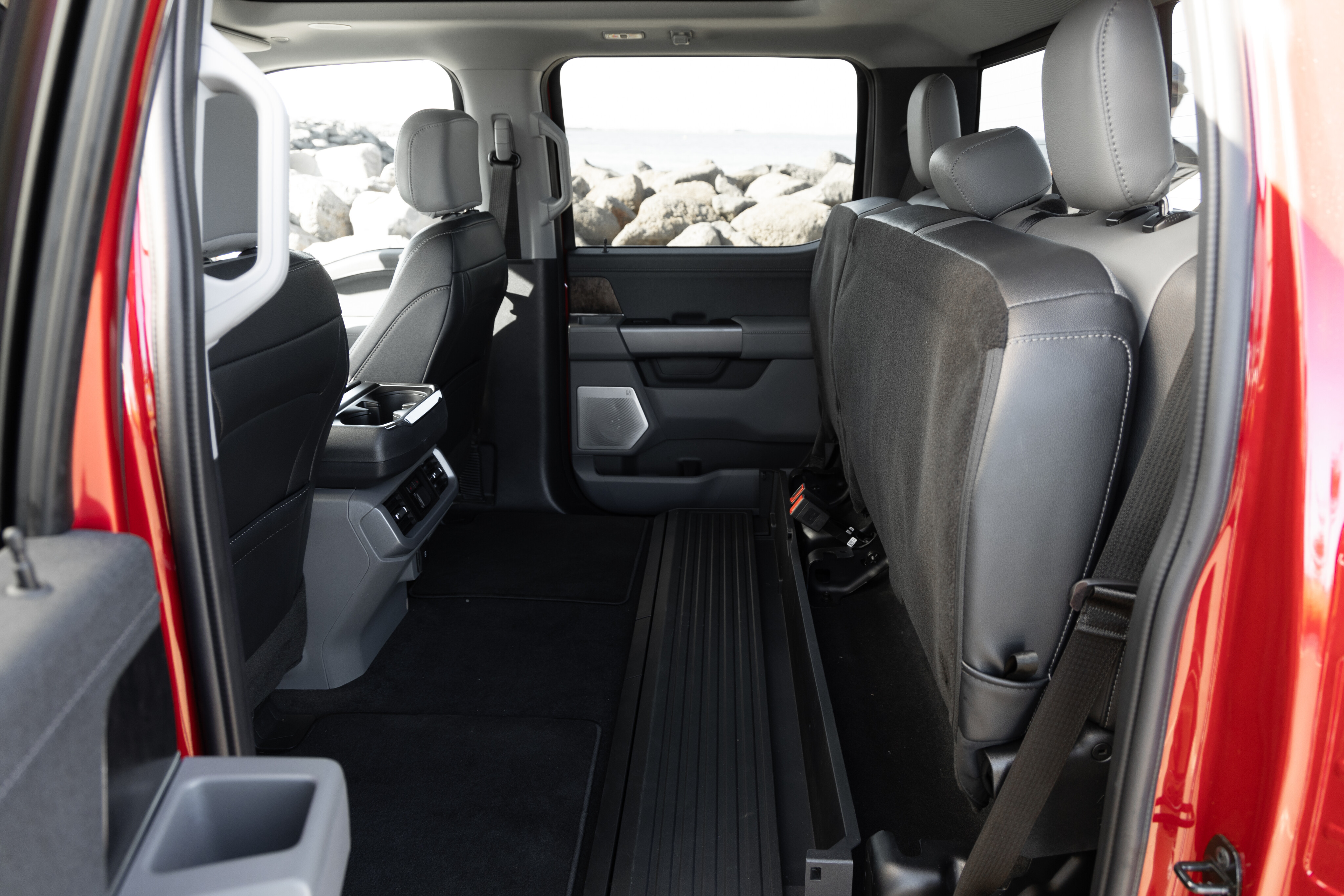
What really sets the Lariat apart from XLT, however, are its screens.
In such a large and broad cabin, the XLT’s 8.0-inch centre screen looks comically small and its resolution also isn’t as clear as the bigger screen in the Lariat.
That helps to make the Lariat easier to park (the video feed from the 360 degree camera is clearer) and the bigger screen is also a benefit if you’re towing, especially if you plan on using the F-150’s clever tech when reversing a boat or trailer (more on this below).

What’s it like to drive?
On the move, you might expect the F-150 to feel big, boaty and ponderous. But, amazingly, it drives a lot like a supersized Ford Ranger.
And that’s high praise indeed. Part of the F-150’s dynamic cohesion can be credited to RMA’s conversion work, which included giving our F-150s a unique steering tune.
Aussie versions of the F-150 use the steering rack from the Ford Ranger Raptor and it’s been tuned by Ford’s engineering team at the You Yangs proving ground the deliver better on-centre feel and response.
It’s a change you appreciate most when driving the F-150 on fast, sweeping country roads. Vague steering robs driver confidence, especially at high speed, yet our F-150s are reassuringly responsive and accurate which makes it easy to place the big ute exactly where you want it on the road.
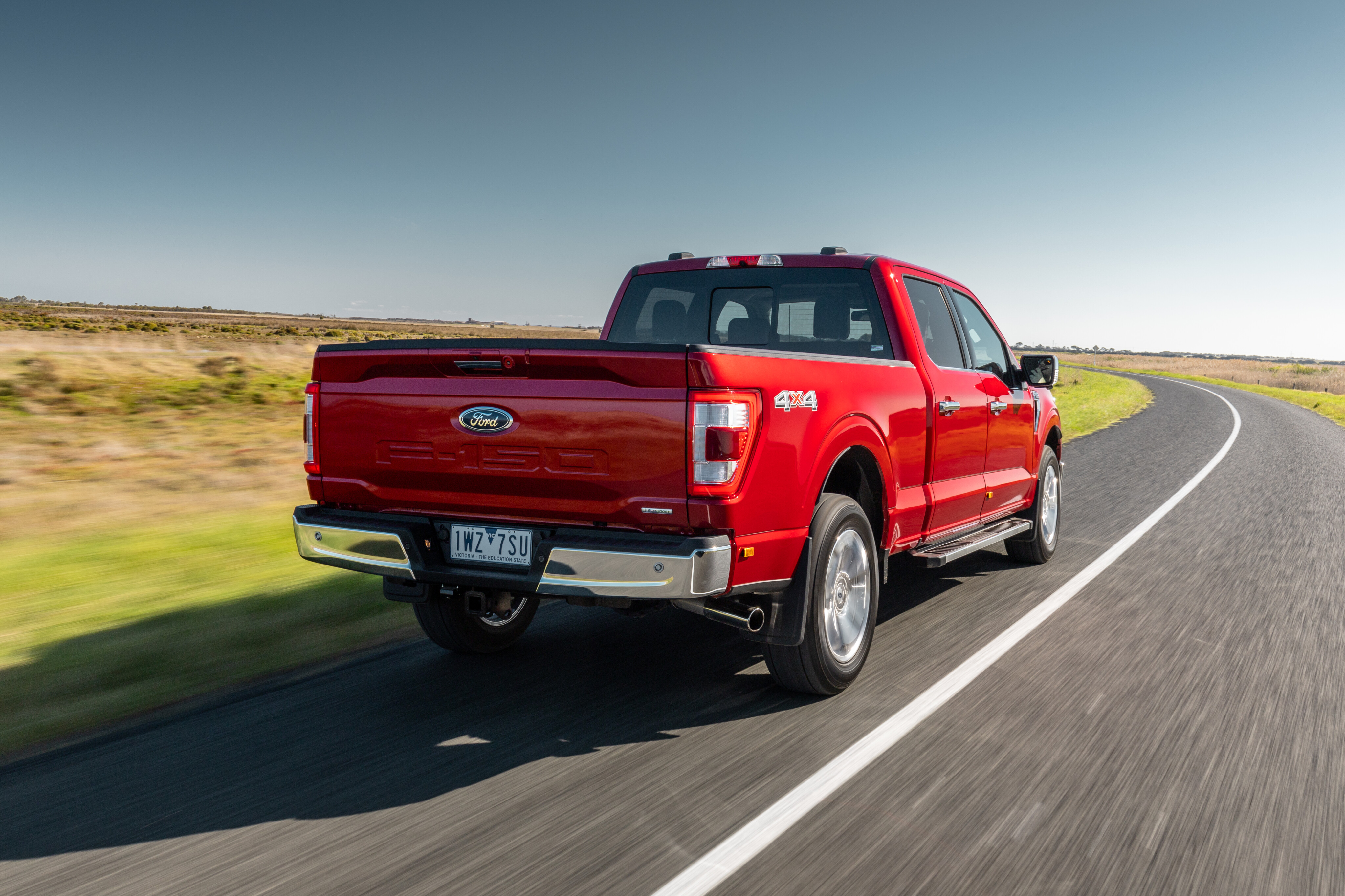
The rest of the F-150’s chassis and suspension is unchanged from the US version. That means an independent coil-sprung front end and leaf springs outback and the good news is that the ride/handling balance is nicely judged.
There’s decent compliance on passive dampers, even on poor roads and despite the large 20-inch alloys, and while you do occasionally notice the telltale tremors and lateral shimmy that plague all light-commercial vehicles, the suspension does an excellent job of controlling the F-150’s mass.
Speaking of weight, the F-150 isn’t as hefty as you might expect. The XLT SWB hits the scales at 2451kg, which actually makes it lighter and faster than the Ford Ranger Raptor. Ford’s engineers sheepishly admitted they’ve clocked the XLT in the high 5.0sec bracket for the 0-100km/h dash.

The Lariat LWB weighs about 100kg more and while you do notice it loses some of the short wheelbase’s punch, there’s still ample performance for towing and to execute easy overtakes.
The twin-turbo V6 is a strong engine – its down slightly for outright grunt compared to the V8s in the RAM and Chevy but it trumps both for torque – and it pairs well with the 10-speed auto, which shifts through cogs smoothly and decisively. The F-150 is also armed with a 136L fuel tank which should provide 1000km+ of cruising range.
And it’s long-distance cruising that the F-150 will excel at. Cabin refinement is impressive, vision out is excellent (the extra cutout of glass in the front side windows makes a huge difference) and the seat comfort and space offered in both rows is superb. The rear seats, in particular, are hugely spacious and offer business-class levels of knee room.
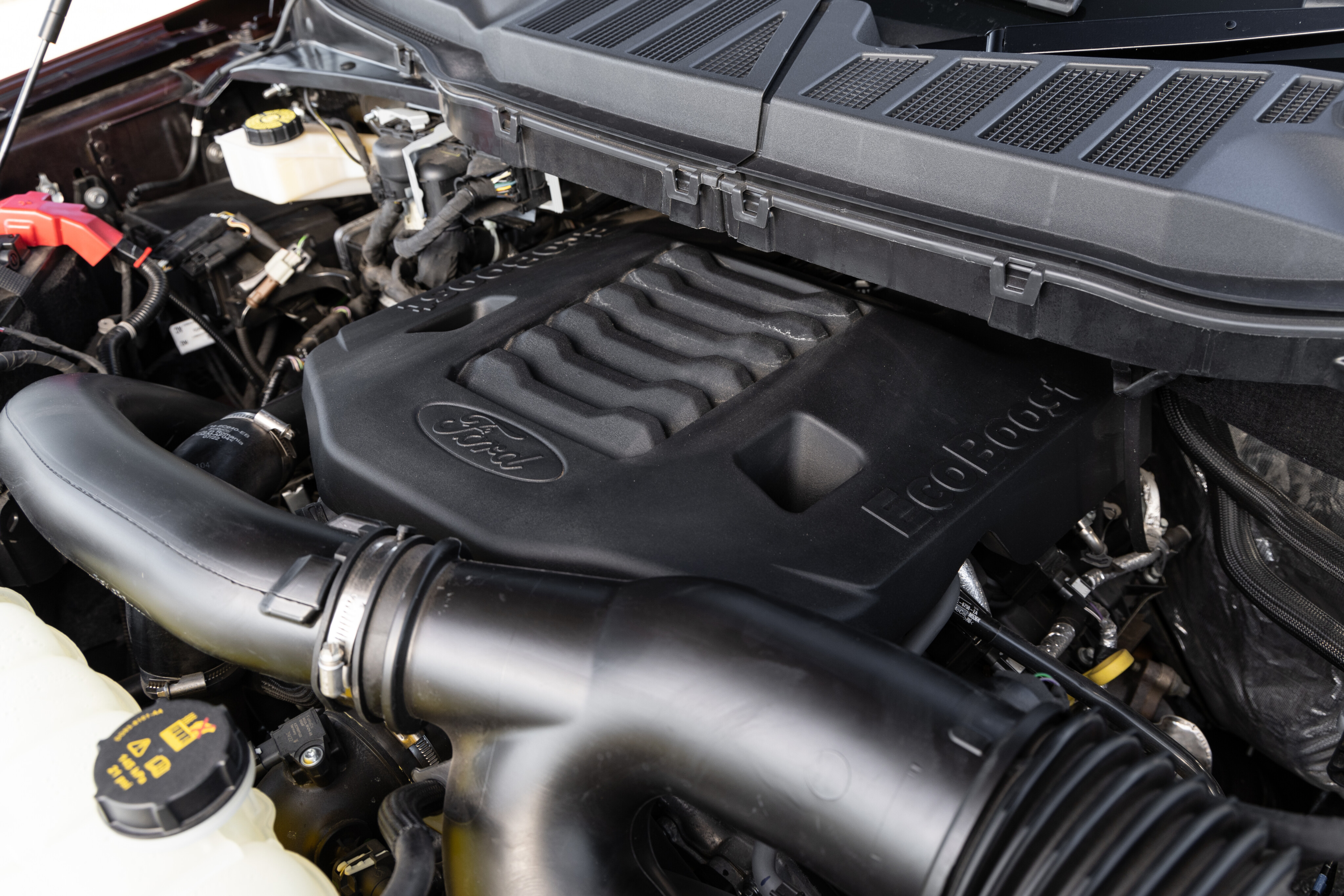
A quick word on towing and payload
Aussie F-150’s feature a locally developed tow bar and are rated to tow 4500kg with a 70mm tow ball or 3500kg with a 50mm tow ball. We towed a 3.5T caravan during our time behind the wheel and the F-150 barely broke a sweat, though it would spin up the wheels if left in two-wheel drive.
Switching to tow/haul mode helped, as did toggling the 4x4 system into 4-Auto, which is another reason to choose the Lariat if you plan on regularly towing heavy loads.
As for payload, long-wheelbase versions are rated at 794kg and 710kg for the XLT and Lariat respectively, which isn’t only lower than the payload of the RAM 1500 and Chevrolet Silverado (878kg and 757kg) but actually less than you get from most mid-size dual-cab utes like the Ford Ranger.
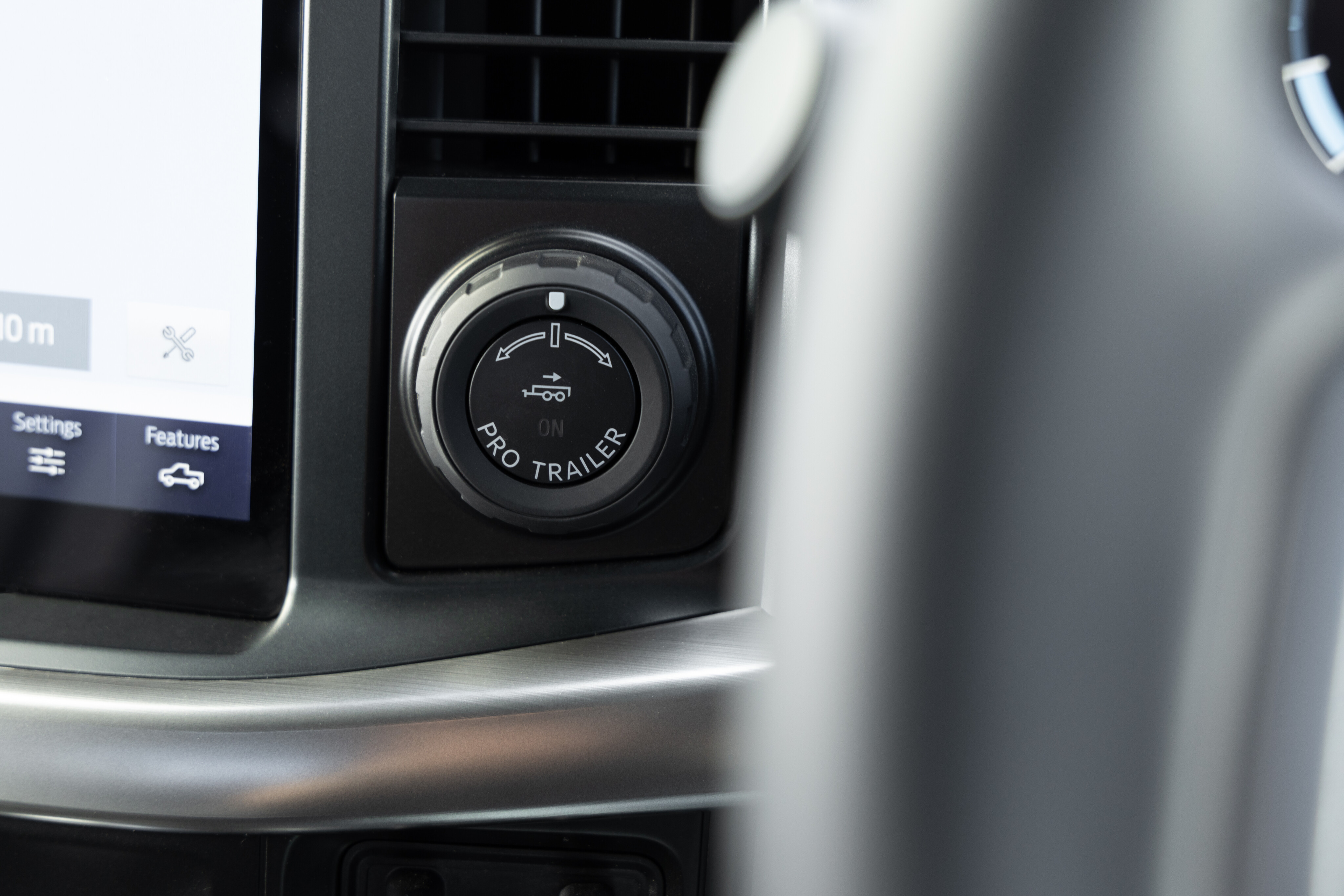
Remember that clever towing tech we mentioned earlier?
Ford has fitted the F-150 with a system called ‘Pro Trailer Backup Assist’, which is feature designed to take the stress and mental gymnastics out of reversing a caravan or boat. Rather than forcing the driver to counter-intuitively turn the steering wheel in the opposite direction they want the trailer to go, the system instead asks drivers to ‘steer’ via a small dial mounted on the dash.
Using the dial allows drivers to simply twist it in the direction they want to move the trailer and then, using a yaw sensor mounted to the front of the trailer and the F-150’s cameras, the ute turns the steering wheel accordingly. It can take some getting used to, especially if you have lots of experience at towing, but it works well.
How much fuel does the Ford F-150 use?
You might think using a V6 twin-turbo instead of a V8 would give the F-150 an efficiency advantage over the RAM 1500 and Chevrolet Silverado, but weirdly, the Ford is actually thirstier.
At least on the official combined cycle. The F-150’s official consumption figure is 12.5L/100km, which is marginally higher than its key rivals which are both rated at 12.2L/100km.
Happily, it seems that buyers can expect their F-150 to get close to (or even beat) that official claim. During our time with the ute we recorded 12.4L/100km over a decent mix of urban and highway driving, which is encouraging. That figure will rise once you drop a load in the tray or hitch a trailer, of course.
Warranty and servicing costs
The 2023 Ford F-150 comes with a factory backed five year/unlimited km warranty.
While that coverage period is fast becoming the industry standard, in the F-150’s case it’s a key reason to buy one over its key rivals. The warranty period for both the RAM 1500 and Chevy Silverado is three years/100,000km.
Service intervals are every 12 months/15,000km (whichever occurs first) and Ford is yet to reveal capped price servicing costs.
VERDICT
Love them or loathe them, there’s no escaping that big utes are now big business in Australia.
RAM and Chevrolet are both enjoying incredible sales growth and Toyota is also about to wade into the booming segment with the Tundra. And against those competitors, the Ford F-150 stacks up well. Its powertrain is strong and smooth, it drives well and the conversion work by RMA Automotive feels top notch.
There’s also a decent amount of choice available in the range, from the more affordable XLT to the full laden long wheelbase Lariat.
If pushed, we reckon the Lariat is the one to go for due to its extra features, size and capability. Plus, what’s that saying? Go big or go home?
2023 Ford F-150 specifications
| Lariat LWB | XLT SWB | |
|---|---|---|
| Body | Four-door, five-seat dual-cab ute | Four-door, five-seat dual-cab ute |
| Engine | 3.5L V6, dohc, 24v, twin-turbo | 3.5L V6, dohc, 24v, twin-turbo |
| Power @rpm | 298kW @ 6000rpm | 298kW @ 6000rpm |
| Torque @rpm | 678Nm @ 3100rpm | 678Nm @ 3100rpm |
| Transmission | 10-speed automatic | 10-speed automatic |
| L/W/H | 6184/2030/1995mm | 5884/2030/1995mm |
| Wheelbase | 3994mm | 3694mm |
| Track width | 1725/1735mm | 1725/1735mm |
| Tray L/W/H | 2005/1656/543mm | 1705/1656/543mm |
| Weight | 2555kg | 2451kg |
| Economy | 12.5L/100km | 12.5L/100km |
| Wheels | 20-inch alloy | 20-inch alloy |
| Tyres | 275/60 R 20 Pirelli Scorpion ATR | 275//60 R20 Hankook Dynapro AT2 |
| Braked towing | 4500kg | 4500kg |
| Payload | 710kg | 794kg |
| Price | $140,945 | $106,950 |
Score breakdown
Things we like
- RMA’s conversion work is mighty impressive
- V6TT is strong and responsive. Who needs a V8?
- Ride and handling is nicely judged and superior to US versions
- Clever towing aids work well
Not so much
- A newer MY24 model is already on sale in the US
- Lariat is a whopping $33K more than XLT
- Some buyers still might lust for a V8
- Payload is lower than key rivals



COMMENTS